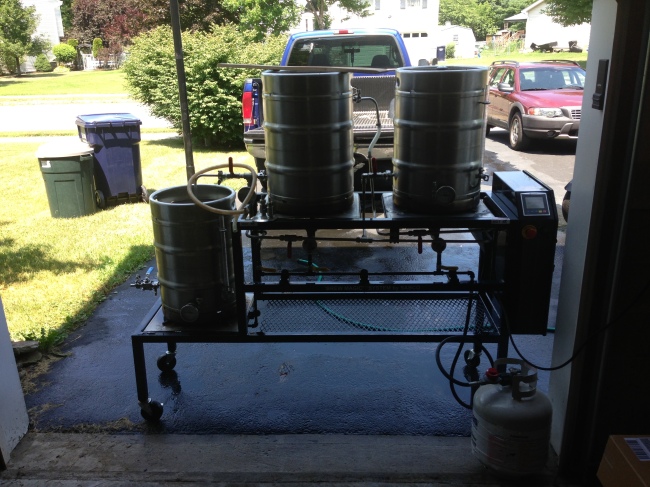Haha, not what you think! The “w” was beautiful…dark, aromatic, sweet…
It took a few days to get ready for the first brew day on the Sabco BrewMagic 350. The system had been relocated, and this was the test day. Worst case, the price of the grain and the cleaning/sanitizing agents would be the cost of this lesson, and best case, five gallons of Milk Stout could be in the pot at the end of the fermentation rainbow. TheBrewSherpa has many years of homebrewing experience, both in all-grain and extract, but this system offered a fantastic opportunity to expand his brewing expertise and get me up and running in a hurry.
With temperatures soaring, near 100F with heavy humidity, this might be a challenge, but nothing would stop us today. We had cleaned and sanitized the barrels, lines, false bottoms, hoses and the chillmaster, pretty sure we had all the supplies we needed.
Light ’em up, and we were heating up the hot water/sparge vessel in anticipation of moving hot water into the mash tun. With the bottom of the mash tun filled with hot water to about 1″ above the false bottom, we added the grains and continued to bottom fill until the grain was submersed. All went well as we circulated the water through the mash for an hour, prior to moving the wort to the boil vessel. Adding water to the hot water/sparge tank, we rinsed with grain until the desired amount of wort was ready to boil. TheBrewSirdar was displeased with the lack of hops addition to the boil, however, our east coast Milk Stout was destined to be low on the IBU scale. Lactose was added at this point and the boil proceeded without hitch for a hour.
Milk Stout Recipe (available upon request)
The biggest challenge was found to be in the transfer of liquid from the boil tank to the fermenter. We were able to reduce the temperature of the wort from its 210F to below 80F, but not without seating the water hose into an ice chest while running the final wort through the Chillmaster, and thereafter seating the fermenter in ice to achieve our desired pitching termperature of 68F.
So now we wait to see how well we did, waiting for fermentation to begin and looking forward to kegging this brew. Any thoughts on the value of secondary fermentation? It seems as if there is an active debate regarding fermentation and racking….
Oh, the spent grains are in the process of becoming dog treats for Lester and Odimus! Please check out our page on the dog treats for the guaranteed doggie-approved recipe.



